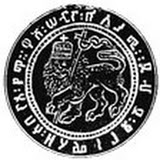Abba, father, priest, and sometimes to elders.
Abyssinia, an old name for Ethiopia.
Abbay, Nile river.
Addis Ababa, a capital of Ethiopia, "New Flower" in Amharic.
Afarsata, imprisoning everyone in a village and starving
them till they surrender a perpetrator.
Amhara, the most powerful Ethnic group in Ethiopia. The
Amharas are located in Central Ethiopia in the province of Shoa.
Amharic, previously the official language of Ethiopia.
Apotheosis, (Greek) climatic moment.
Barya, a slave, slavery exited in Ethiopia until 1930.
Dem, blood.
Eritrea, a state since 1993, previously a province of the
upper North of Ethiopia and Italian colony between 1896 and 1941.
Fasika, Easter, a very big holiday, perhaps celebrated more
than Christmas.
Fukera, a ritual dance.
Galla, a tribe in the South-West of Ethiopia; also, a
derogatory term used in reference to the Oromo people.
Gebbi, palace.
Ge'ez, the ancient written language from which the modern
languages Amharic and Tigrinia have derived.
Gondar, a city north of Addis Ababa and former capital.
Kebra Nagest, Glory of Kings, a main book of Ethiopian history.
Kidane Meheret, the Covenant of Mercy.
Kresta Samra, a holy nun.
Lej Iyasu, a grandson of the Emperor Menelik, deposed in
1916 by Ras Tafari.
Lion of Juda, the ancient symbol of Imperial House of Ethiopia.
Markato, a vast open market in the center of Addis Ababa.
Malak Uqabe, a guardian angel.
Menelik, Emperor of Ethiopia 1889-1907 (?)
Meskel, Ethiopian cross.
Mystire Tensaea, the Secret or Mystery of the Resurrection.
Negus, a king.
Nega Negus, King of Kings, a chronology of Ethiopian kings.
Negusa Negist, an emperor.
Oromos, people of the Oromo ethnic group, Western Ethiopia.
Ras Tafari, Haile Selassie name before becoming an emperor.
Ras, prince, lord, duke. Ras is the highest of the civilian
ranks given by the Emperor.
Sama, poison ivy, a special kiss.
Shamma, a large shawl made of pure cotton, white, typically
embroidered at the edges and worn by both man and woman.
Shiftas, robbers.
Shoans, people of the Shoan province, Central Ethiopia.
Selam, Hello (Arabic).
Selassie, "Power of Trinity," Amharic.
Sheba, a queen, also Saba and Belkis (Arabic).
St. John, a catholic priest visited Ethiopia in 17th
century.(?)
Tewaheldo, Orthodox.
Tigreans, people of the Tigrai region, Northern Ethiopia.
Yazawd Baal, coronation.
Yellem, "No," an exclamation.
Yodit, queen, Jewish ruler of Ethiopia in 15th century.
Waq, a tribal god of the Oromo ethnic group.
Wallo, a province of Ethiopia located mid Eastern part of
the country.
Wetaderoch, foreigners, soldiers.
Zabania, house guard. Middle class households had a servant
to watch the gates.
Zauditu, (Judith), Empress of Ethiopia.
Zar, superstitious and supernatural evil force. He, she, or
it is believed to possess people.
glossary in FOOD directory
There is no special order in this selection and it's not intended for learning Amharic. We'll post the sites, offering language classes. Some definitions are questionable, but to have them is better than nothing.
Spelling is a constant problem. Including Haile Sellassie name, which often spells with one "l" -- Selassie. In various publications you can see "Work" and "Worq" or even "Worrk" -- all represent the different phonetic interpretations. Perhaps, the best way to solve the problem is to consult with the departments teaching Amharic (UPENN has an extensive web site).
Systems of Measure in Ethiopia
This page has been contributed and is maintained by Yared
Berhane. Please send comments and suggestions to him at fairfax@is.netcom.com
Azq -- A measure of distance about an inch long. People in the
countryside use the distance from the tip of their index finger
to the first fold (Angua).
Sinzir -- A measure of distance from the tip of the middle finger
to the tip of the thumb while the hand is fully extended (could
reach anywhere between six to twelve inches depending on the
length of the hand).
Kend -- A measure of distance from the tip of one's elbow to the
tip of the middle finger. This distance could be anywhere from
from a foot to nearly two feet depending the size of the arm.
Aarb -- A measure of lengh approximately about a yard. Used to
measure woven fabrics like shoals. (Netela, Gabi, Kuta)
Chamma -- A mesure of distance from the back of the heel to the
tip of the big toe. A chamma could be anywhere from a few inches
to aa dozen or more inches depending the size of one's foot.
Enqib -- A measure of volume approximately about one bushel. This
is used to measure grains.
Dawulla -- A volume measure of approximately 50 kgs. The size of
the dawulla depends on the size of the animal (goat or sheep)
that used to inhabit the skin of which the dawulla was made.
Unsed to measure grains.
Ermijja -- A linear distance measure of about a yard of a
person's extended walk.
Senselet-- A linear measure used to measure land. (I do not have
the exact distance of a Senselet at this point, but I will look
it up).
Gasha -- An area measure of land. (25 Senselet Squared) (A Gasha
is 25 Senselet by 25 Senselet).
Tassa, Ensira, Gerewoina and Gan -- These are containers of
liquids which are also used to measure volume. A Tassa is about a
litre, Ensira depends on how big the container happens to be
anywhere from two to several gallons, Gerewoina is about 20 or 30
litres (I have to check), and a Gan is several gallons.
Feresulla -- This is a kind of volume measure that seems to
change with the item being measured. A Feresulla Qibe (butter)
is different from a Feresulla Mar (honey) and this is different
from a Feresulla Berbere (Red peppers).
Quintal -- A hunderd kgs. of weight (This looks like it may have
come with modern measuring instruments).





